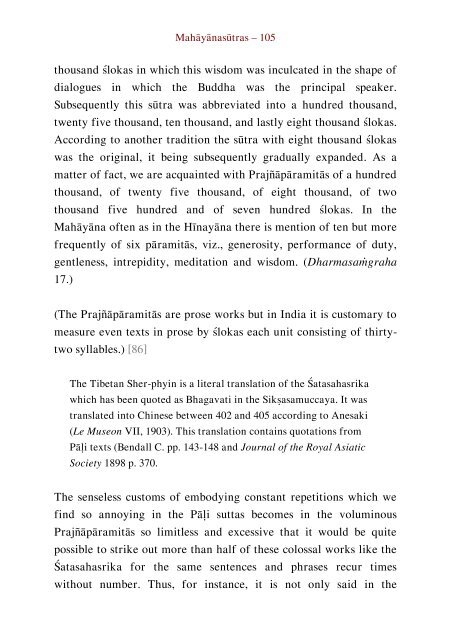Literary History of Sanskrit Buddhism
A study by J. K. Nariman of Sanskrit Buddhism from the Early Buddhist Tradition up to the Mahayana texts proper.
A study by J. K. Nariman of Sanskrit Buddhism from the Early Buddhist Tradition up to the Mahayana texts proper.
Create successful ePaper yourself
Turn your PDF publications into a flip-book with our unique Google optimized e-Paper software.
Mahāyānasūtras – 105<br />
thousand ślokas in which this wisdom was inculcated in the shape <strong>of</strong><br />
dialogues in which the Buddha was the principal speaker.<br />
Subsequently this sūtra was abbreviated into a hundred thousand,<br />
twenty five thousand, ten thousand, and lastly eight thousand ślokas.<br />
According to another tradition the sūtra with eight thousand ślokas<br />
was the original, it being subsequently gradually expanded. As a<br />
matter <strong>of</strong> fact, we are acquainted with Prajñāpāramitās <strong>of</strong> a hundred<br />
thousand, <strong>of</strong> twenty five thousand, <strong>of</strong> eight thousand, <strong>of</strong> two<br />
thousand five hundred and <strong>of</strong> seven hundred ślokas. In the<br />
Mahāyāna <strong>of</strong>ten as in the Hīnayāna there is mention <strong>of</strong> ten but more<br />
frequently <strong>of</strong> six pāramitās, viz., generosity, performance <strong>of</strong> duty,<br />
gentleness, intrepidity, meditation and wisdom. (Dharmasaṁgraha<br />
17.)<br />
(The Prajñāpāramitās are prose works but in India it is customary to<br />
measure even texts in prose by ślokas each unit consisting <strong>of</strong> thirtytwo<br />
syllables.) [86]<br />
The Tibetan Sher-phyin is a literal translation <strong>of</strong> the Śatasahasrika<br />
which has been quoted as Bhagavati in the Sikṣasamuccaya. It was<br />
translated into Chinese between 402 and 405 according to Anesaki<br />
(Le Museon VII, 1903). This translation contains quotations from<br />
Pāḷi texts (Bendall C. pp. 143-148 and Journal <strong>of</strong> the Royal Asiatic<br />
Society 1898 p. 370.<br />
The senseless customs <strong>of</strong> embodying constant repetitions which we<br />
find so annoying in the Pāḷi suttas becomes in the voluminous<br />
Prajñāpāramitās so limitless and excessive that it would be quite<br />
possible to strike out more than half <strong>of</strong> these colossal works like the<br />
Śatasahasrika for the same sentences and phrases recur times<br />
without number. Thus, for instance, it is not only said in the


















